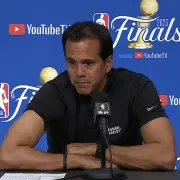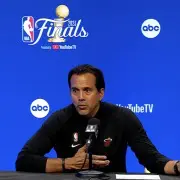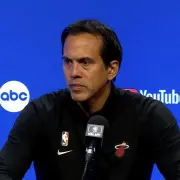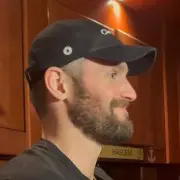Pressure Point: Heat, Panthers give S. Florida rare gift, face challenges
The malaise felt today in South Florida is the hangover from two exhilarating months of thrills and delights from an improbable dual championship pursuit by the Miami Heat and Florida Panthers ending with an abrupt thud on consecutive nights.
These two teams in very different sports linked by geography adhered to parallel scripts all the way to the bitter end, from No. 8 seeds that barely made it into the playoffs to riding companion waves of destiny that carried to their respective finals but washed out short of the trophy presentations.
We certainly hoped for a parade or two, but couldn’t have expected any more effort than these two teams gave us.
That was underscored in the wake of the Panthers’ humbling 9-3 exit at Vegas on Tuesday night when Panthers coach Paul Maurice revealed that four of his players had broken bones, including superstar Matthew Tkachuk with a fractured sternum.
In the spirit sharing the pain, Heat star Jimmy Butler sprained an ankle during the playoffs and appeared limited in the NBA Finals, though he discounted it was a factor. (Certainly doesn’t account for why he rushed that last desperation shot with 17 seconds left and ample time to work for something better.)
Playoffs take physical toll
Injuries aren’t an excuse. By any objective assessment, the Heat and Panthers were beaten in every phase of the game in their finals. The Panthers, for chrissakes, went 0 for 14 on the power play in the Stanley Cup final and gave up a short-handed goal to begin the Game 5 blowout.
The Denver Nuggets and Vegas Golden Knights were the superior team and deserving champion in each final series.
Still it is a letdown for South Florida because of how difficult it is to get to a championship series, and we may never see the likes of this again.
The Panthers and Heat nearly didn’t make the playoffs this year and will find it challenging to get back next season.
The Heat was overpowered by the Nuggets’ big men, just as they were by the Lakers in the 2020 NBA Finals. More brawn is needed in the front court, has been for years.
But it will be difficult just to keep key parts of this roster together due to salary cap constraints.
Heat in salary cap bind
The Heat already has $176 million in payroll commitments to 10 players for 2023-24; the cap is expected to be around $134 million. Three of five starters in the Finals — Gabe Vincent, Max Strus and Kevin Love — will be unrestricted free agents.
The team is committed to one more season at $29.6 million for aging guard Kyle Lowry. Duncan Robinson, relegated to a reserve role for most of the season though a bright spot in the NBA Finals, is owed $18.1 million next season.
Still, Pat Riley and salary cap guru Andy Elisburg have been painted into a corner by burdensome contracts before and found creative ways out. Already rumors and speculation are linking Portland’s eight-time All-Star point guard Damian Lillard and Washington Wizards veteran guard Bradley Beal to the Heat.
So expect the offseason to be intriguing, though far less entertaining than the playoff run.
Bill Zito, in three years as Panthers general manager, has also proved to be astute at roster reshaping, notably swinging the deal for Tkachuk while up against the salary cap ceiling.
With the Keith Yandle contract coming off the books, Zito has about $10 million in cap space to work with this summer.
Incredibly upset
You fight so hard to get here. You take nothing for granted.
32 teams, this truly is the hardest trophy to win in professional sports.
You never know if you’ll get the chance again.Thank you, Florida for an incredible season.
This stings and will for a long… pic.twitter.com/QTwlgwVCWz— Adam Reid (@AdamReid_) June 14, 2023
Several Panthers facing surgery
The problem for the Panthers will be in recovering from this grueling playoff run. Maurice said Tuesday night that several players will need surgery and face months of recovery.
The NHL season opener is about four months away.
The physical toll and effort expended by both teams lends perspective to the spectacle of the past two months in South Florida sports.
“You can appreciate it now. What we went through is miraculous,” said Panthers defenseman Aaron Ekblad, who during the playoffs broke a foot, twice dislocated a shoulder and tore an oblique.
“The way some guys played and collectively as a team the way we played was pretty incredible.”
The region has had a fair share of championships but having a pair of lovable overachievers locked in on the same pursuit simultaneously was remarkable to experience.
Max Strus asked about his past 2 season with the Heat:
“I couldn’t have asked for anything more.”
Says they gave him an opportunity and he’s forever thankful
“This place is always going to have a special place in my heart.”
— Brady Hawk (@BradyHawk305) June 14, 2023
Dual playoff runs captivated South Florida
For weeks we ate dinner in front of the TV or flocked to sports bars and arenas in neighboring counties (even for away games). We stayed up until 2 a.m. to see the Panthers win in four overtimes over the Hurricanes at Carolina to open the Eastern Conference finals.
We saw the Heat squander a 3-0 series advantage in their Eastern finals, losing a heartbreaker at home in Game 6, only to somehow throttle the Celtics in Game 7 in Boston.
Watching the Heat and Panthers win their respective Game 7s to eliminate Boston teams in their shared arena were high points of the whole postseason from a South Florida perspective. The opposite feeling is shared now.
Or as Maurice said, “This is one of the top four or five bad days of your life when you lose in the Stanley Cup.”
Then he added, “but even now standing here, I love those guys. They gave me a great year of my life.”
The Panthers and Heat have given all of South Florida a great gift. Now the baton passes to the baseball Marlins (currently in playoff position) and the football Dolphins and Hurricanes.
Hopefully dream chasing becomes contagious around here.
Craig Davis has covered South Florida sports and teams for four decades. Follow him on Twitter @CraigDavisRuns

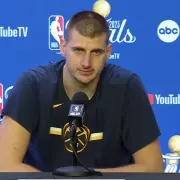
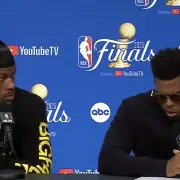

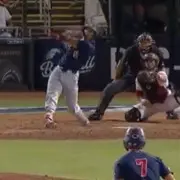

 (@11point7)
(@11point7) 